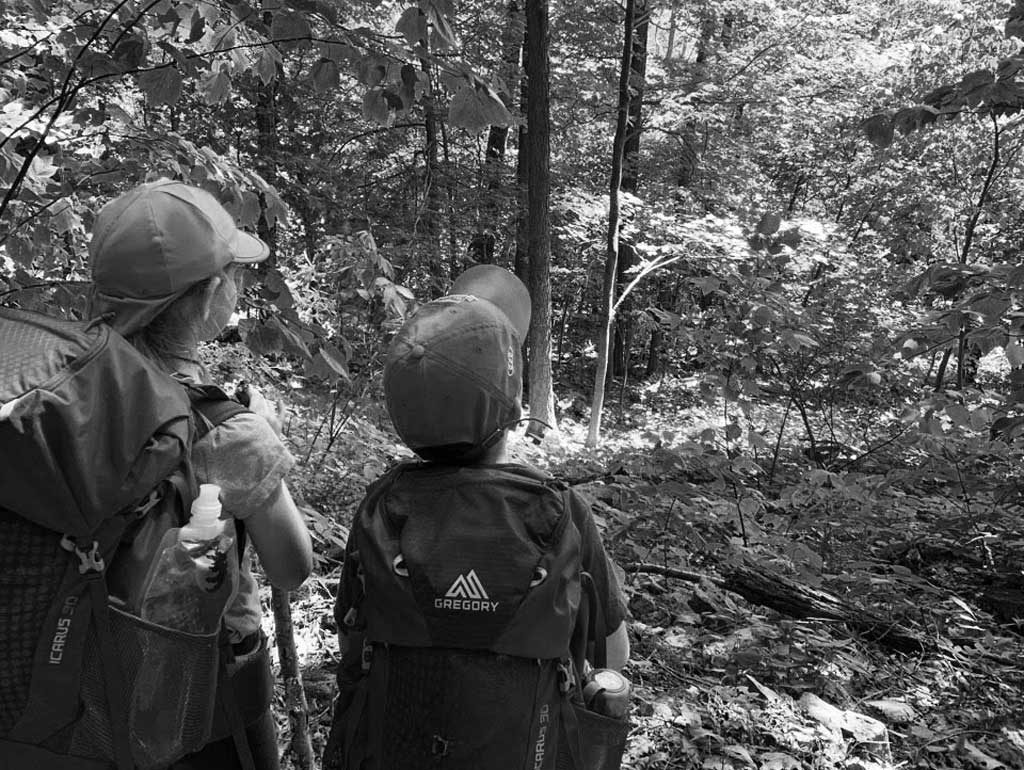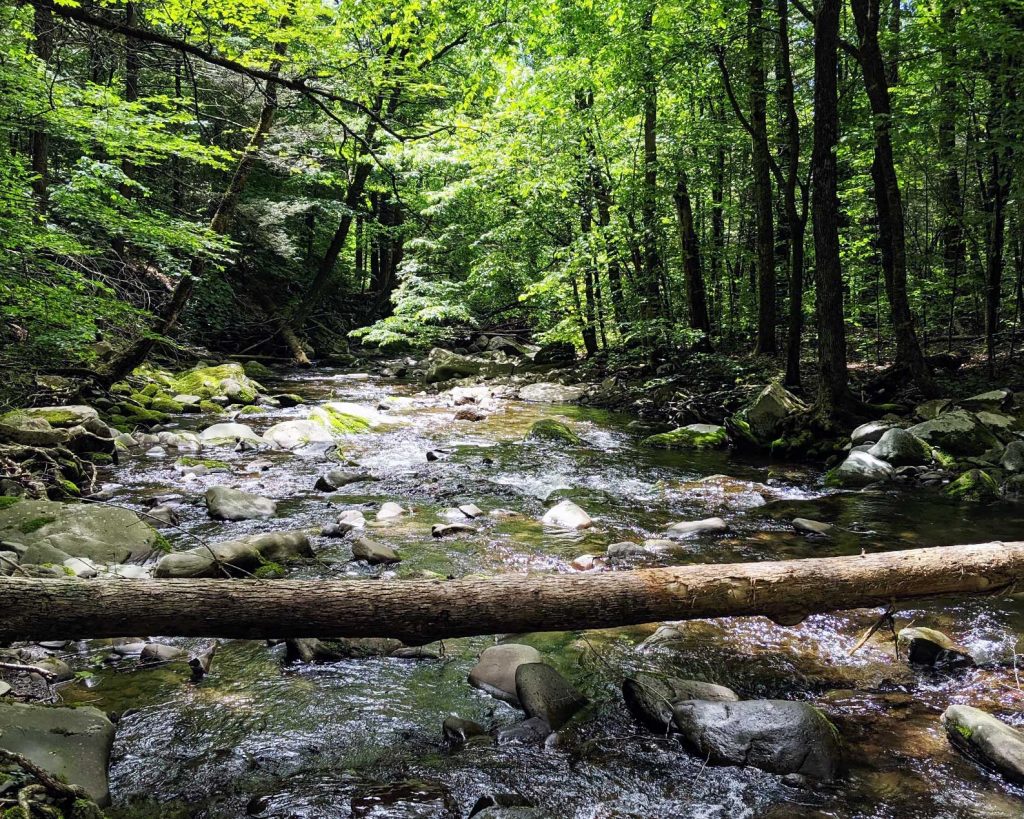Notes: Hiking The Catskills With Six-Year-Olds
From gear to snacks, a guide to getting kids into nature

Taking off my hiking boots and Smartwool socks, I step barefoot into the rushing water, telling my six-year-old son to climb up on my back. The river is cold and swift, and there’s simply no easy way to ford it. We are in a wild section of the Catskill mountains in upstate New York, and the only viable camping spot is on the other side of the river. Is Max concerned? A laugh in my ear assures me that he is not. Neither he nor his friend Sophie has been frightened by the slippery vertical trails, the huge pile of bear scat, or the half-dozen poisonous snakes we’ve seen on the trail. So, crossing a river on dad’s back is no problem.
Max, Sophie and their friends have been intensely focused on the environment this year. He continually talks about protecting nature and “saving the world.” Talking the talk is easy, and the fight to save the environment is all too real. So I wanted to get my NYC-born son far enough out into the mountains to see what he’s fighting for. Far enough that we’d have to create a camp for ourselves, filter our own water, and pack out every piece of refuse.
The only other kid we know tough enough for the hike is Sophie. Born a few days before Max, Sophie has a bit of Brooklyn bare-knuckle bruiser about her. Her dad, Corey, is an A&R professional originally from upstate. We agree on a two-day hike on a remote and under-trafficked section of the Long Path, which begins at the west end of the George Washington Bridge and ends in Albany.
We will backcountry camp, finding a spot in the woods 150 feet from any trail or water source. Some call it “primitive camping” since there are no amenities of any kind except what you bring with you. In all, the hike is almost nine miles—not to mention the thousands of feet of elevation change.

A backcountry trip demands the right equipment. Everything you bring will be carried on your back, weather conditions can vary punishingly, and if someone is hurt, help isn’t a simple phone call away. We spent some six weeks gathering equipment and tried to keep an eye out for brands that are environmentally sensitive, and products that will last years and many uses.
We reach the Catskills on Friday afternoon, and spend our first evening at a designated camp site, using a new BMW X7 SUV as our mobile home. It’s a big vehicle with three rows of seats, and easily fits the four of us and our gear. The folding tailgate makes an ideal place to organize our internal-frame Gregory backpacks.

When packing for a hike, the heaviest items should sit between your shoulder blades; sleeping bags deep inside the pack and out of the way, and nothing hanging from the outside. The kid’s Gregory Icarus 30 backpacks have adjustable torso lengths, hip belts, and an integrated safety whistle. (They are essentially pared-down versions of our adult Baltoro 75 bags.) Compressing clothes, jackets and sleeping bags into separate waterproof stuff sacks is also key. The sacks keep items dry and backpacks properly balanced. Sea To Summit makes compression sacks that are waterproof but able to expel excess air. Items you want to reach quickly—like the kids’ North Face Allproof rain jackets—are on outside stuff sacks for easy access. (Corey and I are using hiking-oriented North Face Dryzzle rain jackets.) Rain is in the forecast, so we’re anticipating.

Before we hike, we charge our electronics using the Goal Zero Yeti 400, a smart lithium-ion battery pack that has enough punch to power a mini fridge for seven hours. We plug in everything at once: cellphones (for photos; we’ll get no reception), headlamps (the kids get their own Wiz headlamps, which shine in various colors, over which they become obsessed), and Goal Zero Crush lights—tent-appropriate lanterns that accordion into very thin wafers. Lastly, we plug in the SPOT X emergency satellite messenger, which is a QWERTY-equipped satellite device allowing you to text updates to the outside world. It’s also equipped with an SOS function, enabling users to text for help from anywhere in the world, alerting authorities who can hone in on your GPS location.

The next morning we’re ready to start the hike. We park at a trailhead and begin huffing up Willow Trail—a long, tough ascent. Corey, who is six-foot-three, starts at a blistering pace. A mile up, my heart is yammering. The trail travels along a ridge, with several spots that could lead to long falls. Max is a klutz, so I keep an eye on him while trying not to hover. He takes a number of spills but gets up each time, gamely. Meanwhile, we thread through groves of chest-high stinging nettles, which burns a patch of Sophie’s forearm bright red. Corey has an ultralight Adventure Medical Kit 9 in his pack. I also tucked in a “trauma pack” with QuickClot, a fast-acting blood-clotting agent. None of it is needed though, thankfully. Along with various first aid options, the key to hiking with kids is snacks. We’re carrying some 10 pounds of munchies, from organic dried fruit from Corey’s Brooklyn co-op, Honey Stinger mini waffles and energy chews, which use natural honey and are gluten-free.

We step over a massive pile of bear scat, and frequently clap to alert any critters of our presence. We’re about three hours into the hike when we start heading downhill on a series of steep switchbacks. It is tricky and slick. Then we see our first copperhead snake. This one is a baby, some six inches long, and juveniles are known for dispelling all of their venom in a bite. Copperheads often freeze when they sense danger, rather than slithering away, so Corey tries to prod it off the trail with his hiking stick. It immediately coils and strikes the end of the stick. In the next hundred feet, we spy four more.
Apparently, we’ve entered an area that has recently seen hatching. Partly for this reason, we’re all wearing high boots: Sophie and Max have on KEEN Targhee hiking boots with thick waterproof shells, while Corey and I are wearing Vasque boots—mine are the super-light, tech-forward Breeze LT GTX model, which feel like sneakers. The kids are fascinated by the snakes, but otherwise unfazed. Still, I’m thankful when we clear the area.

Finally, the trail bottoms out at Warner Creek, which is wider and faster moving than anticipated. Our topographic map shows that this is the flattest area around, so I look for a suitable campsite. About an hour later, I’ve crossed the river, canvassed back and forth, and finally find a somewhat flat spot without high vegetation or stinging nettles. We’ve got to get the kids and gear across, so we take off our footwear and ferry them across on our backs. I manage to fall into the 40-degree water at least once.
We set up camp, with the kids finding rocks for the fire ring. Corey cuts shavings off a piece of dry wood for tinder to start the fire. There is something talismanic about a good knife, and we’ve brought a beauty: the fixed-blade Kiku, a collaboration between Seattle-based SOG and Japanese designer Kiku Matsuda. The handle is a linen-based composite, and the Japanese steel is keen and durable. Soon a merry fire is going.

I set up our twin two-man tents: the New Hampshire-based NEMO Dragonfly, which weighs less than three pounds and is superbly designed, and the Big Agnes Tiger Wall mtnGLO, which is a tad more cramped, but offers a nifty LED lighting system sewn into the tent itself. We also have a super-fluffy NEMO Punk sleeping bag and two Big Agnes sleeping bags— the kids’ Duster and adults’ Anvil Horn.
Other camp chores include throwing a Sea to Summit dry bag over a tall tree branch to serve as a bear bag and purifying a heap of water from the creek in a Platypus GravityWorks water filter. Of course, we don’t want to carry all of our water, so water filters that strain out giardia and other gunk are essential. The Platypus is ideal because its two-bag system allows you to filter liters of water in mere minutes. We’re also carrying plastic bottles with the filters already inside: the Lifestraw Play for kids, and larger Go for adults. Fill them up at a stream and suck straight from the bottle.
That night is pasta from Good To-Go. These dehydrated meals are prepared by Jennifer Scism, formerly of Bouley and Arcadia. Many entrees are vegetarian or even vegan, and all you have to do is pour boiling water into the packets and wait for 20 minutes. To get that boiling water, we’re using the Jetboil MiniMo stove. Within two minutes we have four piping hot cups of water. We eat up the pasta using design-smart utensils from Gerber. The Compleat is a fork, spoon, and spatula that snaps together and weighs next to nothing. The kids are happy, and soon ready for bed. Corey and I drink some whisky and gaze at the stars.

The next morning we have to get back across the river, and up the toughest part of the trail. (Our course is an “out and back,” so we simply reverse our path from the day before.) Corey comes up with a plan to get us across the river without getting wet: we’ll shimmy across a fallen tree that spans the water. He tries it out, wearing his pack. It isn’t elegant, but it works. The kids climb onto the tree and crab-crawl across. Fearless.
Then it’s back up the most treacherous part, so steep that I have to occasionally pull Max up. Rain is falling, the rocks are slick and we come across another copperhead. Neither kid complains, not once (other than the frequent demands for snacks). Finally, we are back at the top of the mountain, and everything is misty and gorgeous. Any fears that the kids are miserable have vanished. We turn our faces up and taste the rain. This is nature and it is indeed worth fighting for.
Images by Corey Roberts












